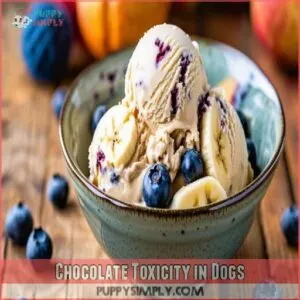This site is supported by our readers. We may earn a commission, at no cost to you, if you purchase through links.
 You can treat your dog to small amounts of plain vanilla ice cream as an occasional treat.
You can treat your dog to small amounts of plain vanilla ice cream as an occasional treat.
While many dogs love a cool lick on a hot day, most are actually lactose intolerant, so moderation is key.
Skip flavors with chocolate, nuts, or artificial sweeteners like xylitol – these can be toxic to your furry friend.
Instead, consider dog-friendly frozen treats like yogurt-based "pup cups" or frozen fruit chunks.
Just like humans watching their waistlines, your pup’s frozen treats should be an occasional indulgence.
Smart pet parents know there’s more to keeping their four-legged friends safe while satisfying their sweet tooth.
Table Of Contents
- Key Takeaways
- Lactose Intolerance in Dogs
- Ice Cream Safe for Dogs to Eat
- Toxic Ingredients to Avoid
- Healthy Alternatives to Ice Cream
- Responsible Pet Ownership and Ice Cream
- Frequently Asked Questions (FAQs)
- What human ice cream is good for dogs?
- Can my dog eat vanilla ice cream?
- Can dogs have sherbet ice cream?
- Can dogs eat ice cream from Dairy Queen?
- How much ice cream can I give my puppy?
- Can dogs eat ice cream cake or milkshakes?
- Is gelato safer than regular ice cream for dogs?
- Does ice cream temperature affect my dogs digestion?
- Why do some dogs handle ice cream better?
- Conclusion
Key Takeaways
- You’ll want to avoid regular ice cream since most dogs are lactose intolerant and can experience digestive issues like diarrhea, vomiting, and stomach pain.
- You must never give your dog ice cream containing toxic ingredients like xylitol, chocolate, caffeine, nuts, or raisins as these can cause serious health problems or even death. Similarly, when considering feeding your dog other treats like fish, be sure to follow safety guidelines, such as avoiding breaded fish options, as these can cause serious health problems or even death.
- You can offer healthier alternatives like fat-free plain yogurt, frozen fruits and vegetables, or specially made commercial dog ice cream treats that are formulated for canine digestion.
- You should consult your veterinarian before introducing any new treats, and if you do give your dog vanilla ice cream, limit it to just 1-2 small licks as an occasional treat.
Lactose Intolerance in Dogs
When you give your dog ice cream, remember that many dogs are lactose intolerant and might’ve tummy troubles.
Their bodies produce less lactase as they age, making it hard to digest dairy, which can cause stomachaches and other digestive issues.
Digestive Issues Caused by Lactose
Lactose intolerance in dogs leads to some stomach-grumbling drama.
When your pup takes in lactose without enough lactase, they might face digestive symptoms like cramps, diarrhea, or gas.
It’s like letting a lactose party in a lactose-free zone.
Some cheeses, like cream cheese for dogs, can be particularly problematic if not given in moderation.
To avoid this mess, remember these points:
- Monitor their reactions carefully.
- Start introducing lactose in very small amounts.
- If you’re looking for a cool treat that’s similar to ice cream, try plain, unsweetened yogurt for dogs basics. Consider yogurt alternatives or specific dog food brands.
Importance of Lactase Enzyme
So, your pup’s tummy’s upset after some dairy?
That’s because they’re likely lactose intolerant.
The problem?
Not enough lactase, the enzyme that breaks down milk sugar.
Without it, dairy causes digestive distress.
Think of it like trying to eat a steak without teeth – it’s not gonna go well!
Providing lactase supplements might help some dogs digest dairy better.
Always check with your vet before making any dietary changes.
Symptoms of Lactose Intolerance
Your dog can’t tell you when something’s off, but there are telltale signs they might be struggling with lactose.
If you’re worried, consider lactose-free options like lactose-free dog ice cream products available online at places like Lactose-Free Dog Treats.
Keep an eye out for these symptoms:
- Diarrhea and Loose Stools – Frequent bathroom trips can be a red flag.
- Vomiting and Gas – Uh-oh, upset tummy alert!
- Stomach Pain – Pacing or whining might signal discomfort.
Ice Cream Safe for Dogs to Eat
Making sure your furry friend gets the occasional treat without the belly aches can feel like quite the juggling act.
While most dogs just can’t handle regular ice cream due to digestive issues after weaning, there are safer alternatives crafted just for them.
Many dogs are lactose intolerant, which can make enjoying ice cream a challenge, especially with lactose intolerance risks. Dog-friendly ice cream brands are stepping up with treats that skip the gut-wrenching lactose.
You can also find the best dog ice cream at online stores like pet shops.
These treats are tasty, and your pooch will love them without the unpleasant side effects.
Here’s a quick peek at some options:
| Dog-Friendly Ice Cream Option | Key Benefits |
|---|---|
| Yogurt-Based Treats | Lower lactose content |
| Banana “Nice Cream” | Natural sweetness |
| Pumpkin Puree Pops | High fiber content |
| Peanut Butter Frosty | Protein-rich |
When considering ice cream for your dog, it’s crucial to avoid toxic ingredients like chocolate, which contains theobromine and can cause chocolate toxicity risks. Explore homemade dog ice cream recipes or commercial treats that cut down on sugar and unhealthy fats.
Remember, keeping an eye on ice cream and dog weight gain is also part of keeping your pal healthy and active.
Toxic Ingredients to Avoid
When choosing ice cream for your dog, you need to steer clear of toxic ingredients that could harm them.
Xylitol, chocolate, caffeine, and nuts like macadamia nuts or raisins are all dangerous and should be avoided to keep your furry friend safe.
Xylitol and Its Effects on Dogs
When you’re picking safe treats, beware of xylitol, a hidden danger in some sugar-free ice creams.
This sweetener spells trouble for dogs, leading to:
- Vomiting and Lethargy: Your furry friend’s energy drains fast.
- Loss of Coordination: Wobbly walks become a concern.
- Seizures: Serious episodes that need immediate attention.
- Liver Damage: Long-term harm from a simple treat.
Stay xylitol-free, and your dog will thank you!
Chocolate Toxicity in Dogs
Chocolate in any form isn’t a treat your dog needs.
Its toxic mix, including theobromine, sparks chocolate toxicity symptoms like vomiting and hyperactivity.
Even a small chocolate dosage can wreak havoc, so treating chocolate poisoning quickly is essential.
If you’re looking for a sweet treat for your dog, consider exploring dog safe ice cream options.
Stick to safe snacks and keep chocolate substitutes for dogs in mind to prevent chocolate access mishaps.
Caffeine and Coffee-Flavored Ice Cream
Coffee ice cream might sound like a sweet treat, but it’s no joke for dogs.
Caffeine in pet food, specifically coffee ice cream, poses serious dangers.
Dogs can’t handle caffeine—it’s like giving them an espresso shot with alarming effects.
Their sensitivity can lead to rapid heartbeats and pet caffeine poisoning.
Instead, explore coffee ice cream alternatives to keep tails wagging safely.
Nuts and Raisins as Toxic Ingredients
Speaking of toxic ingredients, let’s talk nuts and raisins.
These aren’t just bad for your dog’s tummy; they’re seriously dangerous.
Macadamia nuts, for example, can cause weakness and tremors.
Raisins? They pack a powerful punch, potentially leading to kidney failure.
So, steer clear of these dog poison culprits!
Keep your furry friend safe and happy by choosing treats wisely.
Healthy Alternatives to Ice Cream
When you’re looking for a safe treat for your dog, skip the ice cream and consider healthier options.
Fat-free plain yogurt, frozen fruits and vegetables, or homemade frozen treats can provide delicious and safe alternatives.
Fat-Free Plain Yogurt as a Better Option
If you’re wary of all those toxic ice cream ingredients, try fat-free plain yogurt instead. It’s gentler on your dog’s stomach because it contains less lactose, making it a safer bet.
Here’s why you might choose yogurt over ice cream:
- Yogurt benefits: Rich in probiotics.
- Lactose content: Much lower.
- Homemade yogurt treats: Easy to make.
Frozen Fruit and Vegetables as Treats
Yogurt isn’t the only option; frozen fruits and veggies are great too.
As a safer alternative to ice cream, which can be a health concern due to lactose intolerance in dogs, offering frozen apples, blueberries, and carrots keeps your pup cool and healthy.
It’s like nature’s popsicles!
Check out these options:
| Fruit | Veggie |
|---|---|
| Apples | Green beans |
| Blueberries | Carrots |
| Pineapple | Broccoli |
These treats aren’t just tasty but also safe and enjoyable!
Homemade Frozen Treats With Safe Ingredients
Your kitchen holds endless possibilities for creating tail-wagging frozen treats that’ll keep your pup cool and happy.
Whip up these simple recipes using dog-safe ingredients you probably already have:
- Blend bananas with plain yogurt for a creamy "nice cream"
- Freeze low-sodium chicken broth in ice cube trays
- Mix pumpkin puree with Greek yogurt for protein-packed pops
- Combine mashed watermelon with coconut water for invigorating treats
Commercial Frozen Treats for Dogs
Everyone loves a cool treat, and thankfully, there are plenty of commercial frozen desserts made specifically for dogs.
Cottage cheese with pineapple can be a nutritious snack for dogs in moderation, learn more about low-fat cottage cheese alternatives. Ben & Jerry’s Doggie Desserts leads the pack with their sunflower butter-based treats that dogs can safely enjoy.
| Brand | Key Ingredients | Price Range |
|---|---|---|
| Ben & Jerry’s Doggie Desserts | Sunflower Butter | $4-5 |
| Frosty Paws | Whey Protein | $3-4 |
| The Bear & The Rat | Yogurt, Probiotics | $5-6 |
Responsible Pet Ownership and Ice Cream
You’ll need to check the ingredients carefully before sharing ice cream with your dog since many common flavors contain harmful substances.
As a responsible pet owner, it’s best to consult your veterinarian about safe frozen treats and proper serving sizes for your furry friend.
Researching Safe Foods for Dogs
Protecting your furry friend starts with knowing which foods are safe and which could harm them.
Before offering any human treats, including ice cream, check trusted pet health websites or veterinary resources for detailed toxic ingredients lists.
Stay updated on food safety recalls affecting pet products, and bookmark reliable sources for quick reference.
When in doubt about an ingredient, it’s better to skip it entirely.
Remember that what’s tasty for us mightn’t be safe for our four-legged family members.
Consulting With a Veterinarian for Dietary Advice
A trusted veterinarian is your best guide for making dietary decisions, especially when it comes to treats like ice cream. They’ll consider your dog’s specific health needs, age, and any underlying conditions. Regular check-ups allow them to monitor how different foods affect your pup’s wellbeing.
- They’ll assess your dog’s lactose tolerance
- They can spot early signs of food sensitivities
- They’ll suggest vet-approved alternatives based on nutritional needs
- They can create a personalized treat plan that keeps your furry friend healthy
Frequently Asked Questions (FAQs)
What human ice cream is good for dogs?
Primarily, plain vanilla ice cream poses fewer problems for pups, but it’s still not ideal.
You’re better off skipping human ice cream entirely and choosing dog-specific frozen treats made with sunflower butter or frozen fruits instead.
Can my dog eat vanilla ice cream?
While plain vanilla ice cream isn’t toxic, it’s not recommended for dogs.
They’re lactose intolerant and can get upset stomachs.
Try safer alternatives like frozen yogurt or "nice cream" made from blended bananas instead.
Can dogs have sherbet ice cream?
Sherbet isn’t recommended for your dog.
Though it’s less creamy than regular ice cream, it’s still high in sugar and artificial ingredients.
Try frozen fruit chunks or dog-specific frozen treats instead for a safer option.
Can dogs eat ice cream from Dairy Queen?
90% of dogs experience digestive issues from dairy products.
You shouldn’t give your dog Dairy Queen ice cream – it’s high in sugar and lactose.
Consider safer alternatives like frozen yogurt or banana "nice cream" instead.
How much ice cream can I give my puppy?
It’s best to avoid giving your puppy ice cream altogether.
If you must, limit it to 1-2 small licks as an occasional treat.
Dogs are lactose intolerant, and ice cream can cause digestive issues.
Can dogs eat ice cream cake or milkshakes?
Love your pup? Skip the ice cream cake and milkshakes.
These dairy treats aren’t safe for dogs – they’re packed with lactose, sugar, and potentially harmful ingredients.
Stick to dog-friendly frozen treats instead.
Is gelato safer than regular ice cream for dogs?
Despite being made with similar dairy ingredients, gelato isn’t safer for your dog than regular ice cream.
Both contain lactose that can upset your pup’s stomach, and many gelato flavors include harmful ingredients.
Does ice cream temperature affect my dogs digestion?
Playing it cool won’t help here – temperature doesn’t greatly affect your dog’s digestion of ice cream.
The real concerns are lactose intolerance and sugar content, regardless of whether it’s frozen or melted.
Why do some dogs handle ice cream better?
Some dogs have higher lactase enzyme levels, helping them digest dairy better.
Just like humans, your pup’s ability to handle ice cream depends on their individual genetics and digestive system’s tolerance to lactose.
Conclusion
While treating your pup to ice cream might seem like harmless fun, knowing that dogs can eat coconut cream in moderation, as seen in the benefits of coconut cream for dogs, is important for their safety, and knowing what kind of ice cream dogs can eat is important for their safety.
Stick to small portions of plain vanilla ice cream as an occasional treat, or better yet, explore healthier alternatives like frozen yogurt or fruit-based snacks.
By understanding your dog’s dietary needs and being mindful of harmful ingredients, you’ll keep your furry friend both happy and healthy while still letting them enjoy cool, tasty treats.













